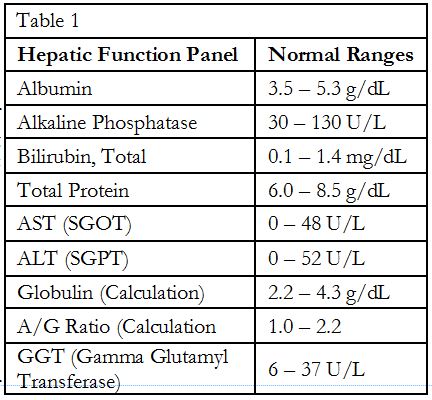Hepatic Function Panel
Dr. Joseph E. Graas, Scientific Director
Dr. Edward Moore, Medical Director
The liver is a vital organ in the body and is responsible for detoxifying the blood that courses through it. The liver is the largest organ in the body weighing 1200 to 1600 grams on average. The organ is shaped like a wedge with the largest portion of the wedge on the right side of the body at about the level of the fifth rib. The circulatory blood system to the liver is separated into two systems; approximately 80% of the blood arrives into the liver via the portal vein and the remaining 20% is supplied from the hepatic artery. These two vascular blood systems supply a large amount of oxygenated and nutrient rich blood continuously to the liver. In addition, there is a large network of lymphatic ducts that carry the interstitial fluid into the general circulation and a network of bile ducts that transport substances excreted or secreted by the liver cells for storage in the gallbladder for use later in the digestive process.
This intricate and complicated organ helps to keeps the body free of harmful agents and it aids in the oxidation and conjugation of drugs in preparation for elimination from the body. The various tests done in a Hepatic Function Panel will aid in the evaluation of the health of the liver detoxifying system. Please see Table 1 for a list of tests that are in a hepatic function panel along with the normal range.
Drugs, alcohol, pesticides etc. can cause irreversible damage to the cellular structure of the liver. This causes the liver to dilapidate and form fibrous tissue inhibiting the normal elimination of waste material. This waste buildup can further the cycle of destruction, effecting the health of the individual. Life and health are predicated on the health of the liver.
The red blood cell has an average life of 120 days and when the cell dies, it releases hemoglobin into the vascular system. This hemoglobin is toxic to the body so the liver converts it into bilirubin, which can then be eliminated. Alcohol, when ingested, will cause trauma to the cells in the liver. The marker for the cell trauma is the enzyme GGT (Gamma Glutamyl Transferase), which is highly specific for the damage caused by excessive alcohol consumption. The alcohol induced liver destruction will also release the other liver enzymes ALT (alanine aminotransferase, AST (aspartate aminotransferase) and Alkaline Phosphatase; however the GGT elevation will specifically indicate alcohol as the liver toxin. The plasma proteins such as albumin, fibrinogen, and globulins are synthesized by the liver. The decrease of albumin and increase of globulin, along with other markers, are characteristic of chronic liver disease. The liver enzymes such as AST and ALT are involved in intermediary metabolism and are present in the liver cells in high concentration. Destruction of the liver cells result in the elevation of these enzymes. The chronic active nature of the hepatitis C virus results in the elevation of ALT, and the elevation of this enzyme is an indicator of the severity of the viral load. These are a few examples of the amount of information contained in the proper interpretation of the results of a Hepatic Function Panel in a normal person.
There is much more information in the Hepatic Function Panel to specifically aid the clinician in the treatment of the addicted individual. The nature of addiction is the use and abuse of a variety of drugs that are a challenge to a normal functioning liver. It is not just the variety and mixture of the drugs, but most often the amount and the duration that the liver has to detoxify. This variable and chronic assault on the cells of the liver causes short term and long term destructive changes. These changes are manifested in scarring of the tissue, death of the cells and changes in the vascular system that feeds the cells. These alterations will greatly impact the metabolism and storage of medication used to treat the addiction, such as methadone and buprenorphine. The evaluation of the data contained in the Hepatic Function Panel will give valuable and diagnostic information to aid in the medicated treatment of the addiction.

The content of this article is intended to provide a cursory overview of the value of the Hepatic Function Panel. For further information, please refer to the medical personnel at your facility. For specific questions, please contact the laboratory that conducted the test.
